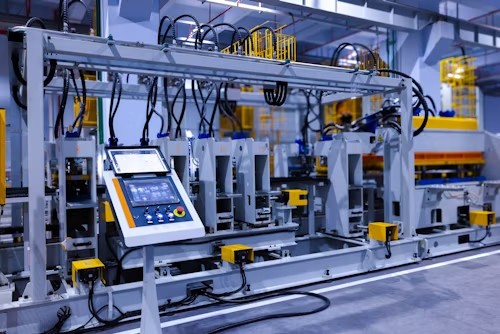
In the modern industrial world, everything works to avoid downtime. The business automation reliability and efficiency systems have become pivotal for almost every sector: manufacturing, logistics or the process industries. It is worth noting that a proximity sensor is equally important to the working of an automated system – the preventive maintenance system – and yet they do not receive the credit they deserve.
This article answers a classic question such as What is a proximity sensor? As well as discuss its importance in modern-day preventive maintenance techniques. For factory owners, be it while upgrading the systems or choosing parts from an industrial automation components supplier shop, these sensors serve a particular purpose which heightens safety, efficiency, return on investment and overall operational metrics, which makes understanding them essential for B2B decision makers.
Understanding what a proximity sensor is
As defined a proximity sensor is a device designed to detect the presence or absence of manually touchable objects, automatically. A proximity sensor uses an electric field or a beam to emit and listens for changes or reflections which indicate the proximity of the object. In opposition to limit switches or contact sensors, proximity sensors operate without any friction or wear and tear, and for any productivity or speed focused controlled environment, these features make the sensors most suitable which is further reason why it is highly valued.
In industrial environments, you will find several category types of proximity sensors:
- Inductive Proximity Sensors: These sensors use electromagnetic fields to detect metal objects.
- Capacitive Proximity Sensors: Capable of detecting metallic and non-metallic items such as glass, plastic, and even liquids.
- Ultrasonic Sensors: Sensors that detect the distance of an object through sound waves and are appropriate for larger ranges of detection.
- Photoelectric Sensors: These sensors utilize light beams to identify objects and are common in packaging and conveyor systems.
When a business seeks explanation on what is a proximity sensor, and how it can be helpful for operational efficiency, the answer lies within its functionality, working truthfully, and silently in the background — enabling automatic responses as well as alert and insight generation.
The Importance of Employing Proximity Sensors in Preventive Maintenance
In the case of preventive maintenance, strategy that concerns performing procedure checks and replacements on equipment prior to rendering it inoperative, proximity sensors are essential in drawing, capturing, and transmitting the equipment’s status and providing early alert signals to avert critical problems.
Following is how proximity sensors enhance the efficiency of preventive maintenance systems:
Monitoring Equipment Performance in Real Time
Proximity sensors track the position and presence of certain components including gears, pistons and even conveyor items. Everything is closely monitored and controlled in order to ensure that something out of the ordinary doesn’t happen, triggers which in turn can enable inspection, maintenance check or even a full shutdown of the system.
As an example, a sensor can inform a technician if any rotating machine components fall out of position. This allows the technician to take corrective measures prior to failure.
Minimum Downtime
Perpetual disruption is an issue that costs most industries dollars, sometimes by the hour, saving anytime work disruption happens is thus vital. Adding a preventive maintenance system integrated with proximity sensors allows companies to track and…
Additionally, preemptive measures also assists lessen the risk of emergency work arising out of direct fixes thus encouraging unique and better alteration, making strategies proactive instead of reactive.
Predictive Maintenance through AI, Analytics and Information Gathering
Data collected is generally for historical analysis, failure mode and effect analysis needs to be done on a certain period of time prior to calculating ease of identifying breakdown indications including maintaining reliable databases…
Such serves to give information encryption to proximity sensors used therefore uploading data directly to cloud storage, aiding industry advanced AI accompanied graduated shifts aka smart factories steer the decision making process in real time.
Enhanced Safety Features
Wasting time and resources isn’t something out of the ordinary, but equipment failure can simply be. Through operating within specific bays designed for actions, peripheral to a defined secure zone enables proximity sensors to heighten reliability greatly…
An industrial automation components supplier must justify the reason for receiving the proximity sensors by explaining the essential feature of the sensor along with their selected models and how each model best fits to assist in the predictive maintenance algorithms within the business.
Selecting Appropriate Proximity Sensors Based on the Application
The right selection of a proximity sensor requires the proper matching of the designed sensor for the environment, equipment, and brand in mind. Take into consideration:
- Type of Material: Metal, liquid, glass and even plastic all have different types of sensors.
- Distance of Sensing: No sensor can go beyond a specific distance or range of detection.
- Condition of Surroundings: Is it dealing with water, dust, chemicals, and even harsh weather?
- Space Around and the Sensor Size: Ensure that the sized sensor can fit into the spaces available in the machines and does not cause interference with the running operations.
- Type of Output: Select from analog and digital outputs considering the needs of the input terminals of the system.
This can also be assisted by a well explained web source that deals with sensors which can explain the features along with the terms supported and scope of assistance, sustain, lifelong.
Integration Tips: Pairing Sensors with Your Automation System
The successful implementation of proximity sensors requires more than their simple installation onto a machine. Their integration into the greater automation system is just as important. This section highlights best practices.
Incorporate Standardized Communication Protocols
Standardized protocols like IO-Link should be incorporated with systems and sensors to ease integration with PLCs, MES, and other systems frameworks. Easy access and advanced diagnostics become available with sensor plug-and-play capabilities.
Document the Sensor Locations
Inaccurate locations frequently lead to misreporting results. Make certain that all sensors are positioned at the recommended angles and ranges for optimal capture.
Use Alongside Temperature Sensors, Pressure Sensors, or Vibration Monitors
Proximity sensors are arguably the best tools to use for object location detection, but their usage is not restricted to other fields. They work best alongside other major condition monitoring sensors such as temperature, pressure, or vibration sensors.
Implement Routine Functional Tests
Sensor reliability may be high, but the implementation of routine functional tests can catch the buildup of dirt, dust, or misalignments before they become a problem.
Working directly with an industrial automation components supplier ensures that companies get implementation guidance, pre-tested solutions, installation training, and support that makes sure sensors start functioning reliably on the very first day.
Real-World Applications and Industry Examples
Understanding how different industries utilize proximity sensors helps illustrate their impact with respect to preventative maintenance. These include:
- Automotive: Car part presence and positioning sensors are critical during assembly. Robots are programmed to operate only when the part is within reach. This eliminates expensive blunders and unnecessary production standstills.
- Food and Beverage: During the bottling process, a capacitive sensor enables contactless monitoring of liquid levels within transparent containers, thus averting overfilling and underfilling situations.
- Pharmaceuticals: Capsule fillers and labeling machines are brought into alignment using proximity sensors to minimize product waste while maximizing throughput.
- Packaging: Sensors monitor conveyor systems for jams as well as misfeeds or other obstructions and activate auto- reset alerts.
These examples demonstrate that preventive maintenance driven by real-time sensing not only cuts costs, but enhances quality and compliance in highly regulated industries.
Conclusion
Learning what is a proximity sensor and how it works with preventive maintenance systems aids in the development of safer and smarter industrial settings. Modern machinery relies on these small but efficient devices to respond proactively and avert failures that would cripple functionality and shorten the working life of the equipment.
When seeking to build or enhance an organization’s automation framework, collaborating with a reputable supplier for industrial automation components facilitates the provided access to advanced sensor technologies, seamless integration, and continuous assistance.
During the era of Industry 4.0, the emphasis isn’t solely on whether a business should employ proximity sensors, but rather on the strategic and intelligent methods of deploying them to derive maximum long-term benefits for the organization.
